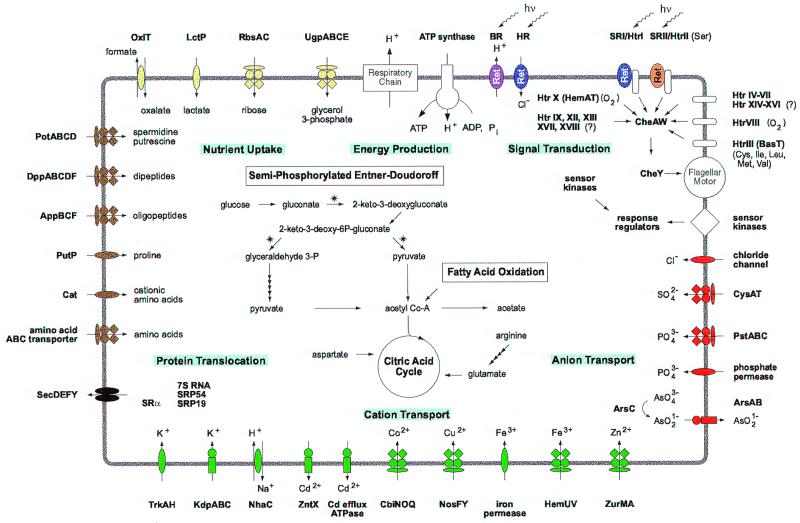Figure 1.
An integrated view of the biology of Halobacterium NRC-1. Aspects of energy production, nutrient uptake, membrane assembly, cation and anion transport, and signal transduction are depicted. ATP synthesis by chemiosmotic coupling of proton transport by the respiratory chain and by light-driven proton pumping by bacteriorhodopsin (BR) (purple oval) or chloride transport by halorhodopsin (HR) (blue oval) is shown. Below, the semiphosphorylated Entner–Doudoroff pathway is shown, and the presence of fatty acid oxidation and the citric acid cycle is indicated. Enzymes not yet identified are marked with asterisks. A variety of nutrient uptake systems (represented by yellow or brown structures) coded by the genome including glycerol 3-phosphate (UgpABCE) and ribose (RbsAC) ABC transporters, a lactate (LctP) transporter, formate-oxalate antiporter (OxiT), spermidine and putrescine uptake ABC transporter (PotABCD), and amino acid (PutP, Cat) and dipeptide (DppABCDF) transporters are shown. Other amino acid uptake systems, represented by a generic ABC transporter, are also likely to exist. Components of the protein translocation machinery (SecDEFY, SRP19, 54, SRα) (in black) are shown. Cation transporters (in green) shown are for K+ (TrkAH, and KdpABC), Na+ (NhaC), Cd2+ (ZntX and Cd efflux ATPase), Co2+ (CbiNOQ), Cu2+ (NosFY), Fe3+ (iron permease and HemUV), and Zn2+ (ZurMA). Anion transporters shown (in red) are for SO42− (CysAT), PO43− (PstABC and phosphate permease), Cl− (chloride channel), and arsenate (ArsABC). A complex system of photoreceptors and signal transduction components are shown, including two sensory receptors (SRI shown in blue and SRII shown in orange), 17 transducers (Htr I, II, III, IV, V, VI, VII, VIII, IX, X, XII, XIII, XIV, XV, XVI, XVII, and XVIII) responding to light (hυ), O2, or amino acids, as indicated. Transmission of the motility signal to the flagellar motor via CheAW and CheY is shown by arrows. Single examples of sensor kinases, membrane bound (white rhombus) or cytoplasmic, and response regulators are identified.

